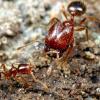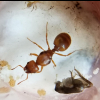Hi,
New person here. I have three ants to ID. I'm not sure if they're all queens or claustral (ant #2 has a big head and smallish gaster). All of the ants were collected in a blacklight trap around 10 PM on a patio in a suburb with a few trees on 7/10/20.
Ant #1
Image: https://imgur.com/a/epatHVR
Length: 7 mm
Dark brownish-red with yellow stripes on the gaster.
Ant #2
Image: https://imgur.com/a/nDsmmtV
Length: 10 mm
Orangish-Brown
Ant #3
Image: https://imgur.com/a/JlDl57O
Length: 13-15 mm
Black gaster, reddish-brown thorax and body



















